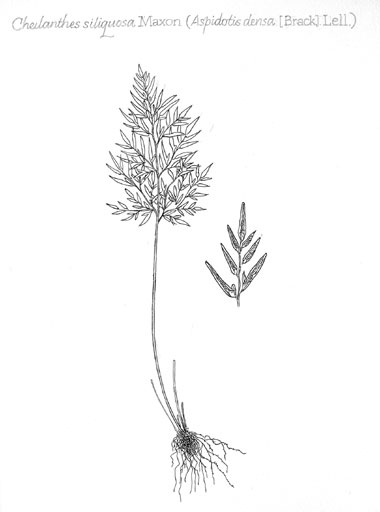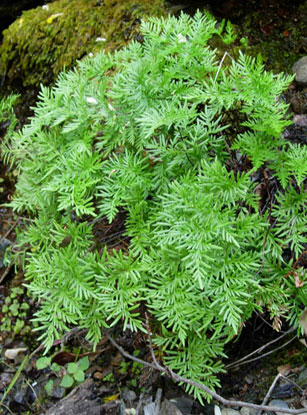| Aspidotis densa | ||
Indian's dream | ||
|
Etymology
Densa means crowded, or thickly packed.
Description
Rhizome: short-creeping, scales brown to black or often bicolored with dark central stripe.
Frond: 25 cm high , evergreen, somewhat dimorphic, fertile fronds with longer stipes and narrower segments, blade/stipe ratio: 1:3. Stipe: dark reddish brown, with single groove, glabrous, vascular bundles: 1. Blade: 3-pinnate at base, or more, triangular, leathery , glabrous. Pinnae: 5 to 7 pair, composed of very narrow segments; pinnules pointed tips; segments linear, 3-8 mm, midrib prominent below; margins entire; veins obscure, free. Sori: sporangia, submarginal, continuous along length of segments except at apex, indusium: false, inrolled margin, broad, thin, dry, sporangia: dark brown. Culture
Habitat: crevices, rocky outcrops, associated with serpentine, sometimes in chaparral.
Distribution: western North America, British Columbia, western Montana south to Califormia, disjunct in Quebec.
Hardy to -30°C, USDA Zone 4, but given the distribution, the source is likely important.
Distinctive Characteristics
The long, narrow segments, the very long stipe, and the broad, thin indusium are distinctive.
Synonyms
Onychium densum Brackenridge Cheilanthes siliquosa Maxon Pellaea densa (Brackenridge) Hooker |
|
|

Aspidotis densa. Illustration by Edgar Paulton, from How to Know the Ferns and Fern Allies, John T. Mickel, © 1979 Wm. C. Brown Co. |

Aspidotis densa. a) taller fertile, shorter (sometimes missing) sterile fronds; b) fertile pinnule. Illustration by V. Fulford from Ferns and Fern Allies of Canada, William J. Cody and Donald M. Britton, 1989, © Agriculture Canada, used with permission. |
